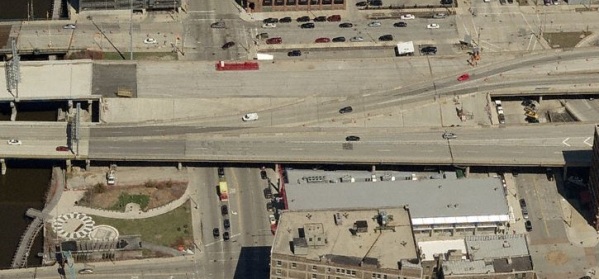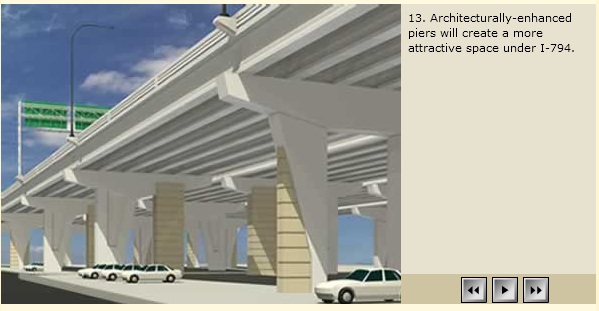Accents on the Interstate, Lipstick on a Pig
If accent lighting on the interstate isn’t the perfect definition of lipstick on a pig, I don’t know what is. That said I’m not opposed to it. In fact, I think dressing the Marquette Interchange for the prom was a positive step forward. There is, however, only one thing I wish would have happened differently.
How could this be achieved? Well, as mentioned previously, putting more lipstick on the pig ala better lighting under the interstate to encourage more pedestrian activity from one side to the other (and hopefully encourage more development).
As I said before…
The idea I like the most is the creation of a barrier between the streets and the parking lots with rotating public art from area students. Mix that with upward shooting lights and more contemporary designed fixtures to achieve an experience under the freeway that is similar to walking along the Riverwalk. Make the area as visually appealing as possible to reduce the negative impact the massive cement structure has on adjacent land.
WisDOT did seem to have some intention of doing something with the space under 794. Hopefully they follow through with that, and do something other than generic surface parking lots and what they refer to as “architecturally-enhanced piers”. The “architecturally-enhanced piers” (pictured blow) were seriously what’s mentioned on MChange.org as all it would take to make the area more appealing.
The other low-hanging fruit (concrete) is the removal of the temporary lanes separating the two portions of 794. It appears in an effort to make the project come in under budget, WisDOT decided to just leave construction pieces at the site (a supposedly temporary concrete piece bigger than the Milwaukee Public Market). Unfortunately, leaving the temporary lanes in place (pictured below) makes the space under the freeway completely dark, negating the “architecturally-enhanced piers”.

The lights on the Marquette Interchange are a good thing. They make driving through downtown more noticeable (if the skyline was failing to do that already) and will probably help the image of the city. My concern is just that WisDOT should be spending more attention to the visual effect the freeway has on the land bordering it in the city. More lighting under the freeway would help.
Ironically, the happy motorists living in the suburbs seem to have an issue with $815,000 being spent on lights, but not on the $810,000,000 cost of the entire project. Ironic? We think so. The entire project did cost 1,000 times as much as the lights. Penny-wise, pound-foolish comes to mind.






















I am in agreement – even though I personally find the lighting ridiculous – because it is distinctive without being offensive.
Distinctive elements are good for a city as a form of organic marketing. It works because people who spend time in the city remember the image and over time the image becomes a symbol of the city in their mind. This symbolization creates a connection between them and the city. And the connection can be effective whether the image is one shared by most the world (the Eiffel Tower, Empire State Bldg) or one that is well-known only to the “exclusive club” who know that city well.
For example, I am reminded of two of Boston’s ugly/ridiculous landmarks that are distinctive, and remembered by most people who have visited or lived there.
1. The Citgo sign – which sits atop the green monster as you watch the Red Sox on TV and is also visible from large swaths of the city, particularly along the river. It stands out positively in my mind bring memories of the Esplanade and Fenway Park, even if in reality it was erected as an advertisement for an oil company.
http://www.flickr.com/photos/briburt/3405815598/
2. The Keyspan LGN tanks, again energy, again gaudy, again memorable to those who have driven the city’s south shore.
http://www.flickr.com/photos/catsrus30/2964593642/
In 20 years, it will seem like the M-Change lighting has always in place. It will not be well known to those outside Milwaukee, but the image is something all residents and visitor’s to the city will share. Whether this form of marketing is worth $800k is debatable because it is so hard to quantify its benefits, but you make a valid point by noting that the lighting is a tiny portion of the road’s total budget.
In response to MetroMilwaukeeToday’s blog post in reaction to what I said, I have a few thoughts.
1. Again, you’re very concerned (and many others are judging by the letters to the editor at the Journal Sentinel) about the $815,000. Which, as I noted before, is roughly 1/1000th of the cost. Or to put it another way, 0.001%. Now if you’re all the sudden concerned about saving money, I would start with perhaps having one less exit? That will save you $30 million at least one could assume.
2. You mention that the area grew since the 1960s. That would actually be largely false. The population just moved, which the Marquette Interchange helped facilitate. So what did we do? We built it bigger to handle a greater number of cars, easing congestion. We loosened our belt to lose weight. Think about the logic in that for a minute. Again, if you wanted to save money, just rebuild it exactly as it was. You would have saved at least $100 million that way.
3. We could have saved jobs by spending the money elsewhere? Did the lights get there by themselves? I think it created jobs to put them in.
Spending 0.001% of the cost of the project on making it look a little better, especially for those that live right next to it was a good idea.
I don’t feel much sympathy for the people who don’t have lights on the freeway. They’re the same people who demand a wider I94 to the stateline, a rebuilt Zoo Interchange, a rebuilt Marquette Interchange, a rebuilt I43 in New Berlin. You can’t constantly be spending on new infrastructure, and expect to keep maintaining your existing infrastructure if your pool of revenue isn’t growing (and especially not when it’s shrinking).
You talk about the interchange being a necessity, and the lights not being one. The interchange is a necessity? Only because we made it one. We could build a roundabout or four-way stop there too, and save $809 million. The interchange helped create the far-reaching suburbs, while at the same time destroying the land adjacent to it. It’s a necessity now, but it wasn’t when it was built. Look at Chicago, they have nothing this big near the Loop, because the freeway there was built with much more respect for the city.
As long as we’re paying for this giant concrete edifice, it’s nice that the state at least spent 0.001% of the project on making it look a little better.
I think that we need more lights. Especially I like the neon lights but when I was going northbound on 94, I barely seen any last night. We need more of that. Also putting more billboards around the downtown area, while coming down the freeways and also on the streets. The large billboards should be put closer to freeway so they would look bigger. Also make them all electronic. Maybe even install large TV panels that will have higher quality of ads. This will give the city a more modern and cosmopolitan look.
People are focusing on the $815,000…how much would conventional lights have cost? My guess is that the conventional lights cost a similar amount.
Jeramey, you hit the nail on the head in your response to MMT.
In regards to your original post, you mention a glimmer of hope that the DOT may have plans for the below-794 space. However, looking at the rendering from their site that you post immediately after that statement, I notice only one thing below the concrete mass: surface parked cars (that look just like the HO scale generic cars I used on my train set as a kid, btw…memories!). Not sure if I share the same optimism.
I think the lights are a nice eye-catching effect, one that shows the city as interested in its public appearance. The fact that it cost $815,000… didn’t the project finish ahead of time and way under budget anyway? Even with this expenditure, we probably still saved money.
Just a note, Jeremy. 1/1000th is 0.1%, not 0.001%.
Still, I’m with you on the point. To focus on that portion is a perfect example of one of Parkinson’s laws, the law of meeting, in which the time spent on an item is inversely proportional to the value of the item.
A lot of suburbs have architectural review boards which mandate that private developers meet certain design conditions on their projects, I am sure that for a lot of those projects the costs of the extra design is at least .1% of the project cost, so why is their a double standard between requirements to keep their communities looking nice, but when it comes to keeping Milwaukee looking nice they get upset and call it wasteful spending?
@Arlen you are 100% correct, 0.1% is what I was going for.
Matt I’d add what about soundwalls along a free? What do they cost? As they limit the audible noise whereas these accents lights attempt to limit the visual noise.